INCENTIVE TO OVERPRODUCE INVENTORY
The absorption of fixed overhead costs as part of the cost of inventory on the balance sheet presents ethical challenges because it provides the opportunity to manipulate reported income. This classic case is based on an actual company’s experience.*
Brandolino Company uses an actual-cost system to apply all production costs to units produced. The plant has a maximum production capacity of 40 million units but during year 1 it produced and sold only 10 million units. There were no beginning or ending inventories. The company’s absorption-costing income statement for year 1 follows:
BRANDOLINO COMPANY
Income Statement
For Year 1
Sales (10,000,000 units at $6)
$ 60,000,000
Cost of goods sold:
Direct costs (material and labor) (10,000,000 at $2)
$20,000,000
Manufacturing overhead
48,000,000
68,000,000
Gross margin
$ (8,000,000)
Less: Selling and administrative expenses
10,000,000
Operating income (loss)
$(18,000,000)
The board of directors is upset about the $18 million loss. A consultant approached the board with the following Page 345offer: “I agree to become president for no fixed salary. But I insist on a year-end bonus of 10 percent of operating income (before considering the bonus).” The board of directors agreed to these terms and hired the consultant as Brandolino’s new president. The new president promptly stepped up production to an annual rate of 30 million units. Sales for year 2 remained at 10 million units. Here is the resulting absorption-costing income statement for year 2:
BRANDOLINO COMPANY
Income Statement
For Year 2
Sales (10,000,000 units at $6)
$60,000,000
Cost of goods sold:
Costs of goods manufactured:
Direct costs (material and labor) (30,000,000 at $2)
$60,000,000
Manufacturing overhead
48,000,000
Total cost of goods
manufactured
$108,000,000
Less: Ending inventory:
Direct costs (material and labor) (20,000,000 at $2)
$40,000,000
Manufacturing overhead (20/30 × $48,000,000)
32,000,000
Total ending inventory costs
$72,000,000
Cost of goods sold
36,000,000
Gross margin
$24,000,000
Less: Selling and administrative expenses
10,000,000
Operating income before bonus
$14,000,000
Bonus
1,400,000
Operating income after bonus
$12,600,000
The day after the year 2 statement was verified, the president took his check for $1,400,000 and resigned to take a job with another corporation. He remarked, “I enjoy challenges. Now that Brandolino Company is in the black, I’d prefer tackling another challenging situation.” (His contract with his new employer is similar to the one he had with Brandolino Company.)
What do you think is going on here?
How would you evaluate the company’s year 2 performance?
Using variable costing, what would operating income be for year 1? For year 2? (Assume that all selling and administrative costs are committed and unchanged.)
Compare those results with the absorption-costing statements.
Comment on the ethical issues in this scenario.
INCENTIVE TO OVERPRODUCE INVENTORY
The absorption of fixed overhead costs as part of the cost of inventory on the balance sheet presents ethical challenges because it provides the opportunity to manipulate reported income. This classic case is based on an actual company’s experience.*
Brandolino Company uses an actual-cost system to apply all production costs to units produced. The plant has a maximum production capacity of 40 million units but during year 1 it produced and sold only 10 million units. There were no beginning or ending inventories. The company’s absorption-costing income statement for year 1 follows:
BRANDOLINO COMPANY
Income Statement
For Year 1
Sales (10,000,000 units at $6)
$ 60,000,000
Cost of goods sold:
Direct costs (material and labor) (10,000,000 at $2)
$20,000,000
Manufacturing overhead
48,000,000
68,000,000
Gross margin
$ (8,000,000)
Less: Selling and administrative expenses
10,000,000
Operating income (loss)
$(18,000,000)
The board of directors is upset about the $18 million loss. A consultant approached the board with the following Page 345offer: “I agree to become president for no fixed salary. But I insist on a year-end bonus of 10 percent of operating income (before considering the bonus).” The board of directors agreed to these terms and hired the consultant as Brandolino’s new president. The new president promptly stepped up production to an annual rate of 30 million units. Sales for year 2 remained at 10 million units. Here is the resulting absorption-costing income statement for year 2:
BRANDOLINO COMPANY
Income Statement
For Year 2
Sales (10,000,000 units at $6)
$60,000,000
Cost of goods sold:
Costs of goods manufactured:
Direct costs (material and labor) (30,000,000 at $2)
$60,000,000
Manufacturing overhead
48,000,000
Total cost of goods
manufactured
$108,000,000
Less: Ending inventory:
Direct costs (material and labor) (20,000,000 at $2)
$40,000,000
Manufacturing overhead (20/30 × $48,000,000)
32,000,000
Total ending inventory costs
$72,000,000
Cost of goods sold
36,000,000
Gross margin
$24,000,000
Less: Selling and administrative expenses
10,000,000
Operating income before bonus
$14,000,000
Bonus
1,400,000
Operating income after bonus
$12,600,000
The day after the year 2 statement was verified, the president took his check for $1,400,000 and resigned to take a job with another corporation. He remarked, “I enjoy challenges. Now that Brandolino Company is in the black, I’d prefer tackling another challenging situation.” (His contract with his new employer is similar to the one he had with Brandolino Company.)
What do you think is going on here?
How would you evaluate the company’s year 2 performance?
Using variable costing, what would operating income be for year 1? For year 2? (Assume that all selling and administrative costs are committed and unchanged.)
Compare those results with the absorption-costing statements.
Comment on the ethical issues in this scenario.
INCENTIVE TO OVERPRODUCE INVENTORY
The absorption of fixed overhead costs as part of the cost of inventory on the balance sheet presents ethical challenges because it provides the opportunity to manipulate reported income. This classic case is based on an actual company’s experience.*
Brandolino Company uses an actual-cost system to apply all production costs to units produced. The plant has a maximum production capacity of 40 million units but during year 1 it produced and sold only 10 million units. There were no beginning or ending inventories. The company’s absorption-costing income statement for year 1 follows:
BRANDOLINO COMPANY
Income Statement
For Year 1
Sales (10,000,000 units at $6)
$ 60,000,000
Cost of goods sold:
Direct costs (material and labor) (10,000,000 at $2)
$20,000,000
Manufacturing overhead
48,000,000
68,000,000
Gross margin
$ (8,000,000)
Less: Selling and administrative expenses
10,000,000
Operating income (loss)
$(18,000,000)
The board of directors is upset about the $18 million loss. A consultant approached the board with the following Page 345offer: “I agree to become president for no fixed salary. But I insist on a year-end bonus of 10 percent of operating income (before considering the bonus).” The board of directors agreed to these terms and hired the consultant as Brandolino’s new president. The new president promptly stepped up production to an annual rate of 30 million units. Sales for year 2 remained at 10 million units. Here is the resulting absorption-costing income statement for year 2:
BRANDOLINO COMPANY
Income Statement
For Year 2
Sales (10,000,000 units at $6)
$60,000,000
Cost of goods sold:
Costs of goods manufactured:
Direct costs (material and labor) (30,000,000 at $2)
$60,000,000
Manufacturing overhead
48,000,000
Total cost of goods
manufactured
$108,000,000
Less: Ending inventory:
Direct costs (material and labor) (20,000,000 at $2)
$40,000,000
Manufacturing overhead (20/30 × $48,000,000)
32,000,000
Total ending inventory costs
$72,000,000
Cost of goods sold
36,000,000
Gross margin
$24,000,000
Less: Selling and administrative expenses
10,000,000
Operating income before bonus
$14,000,000
Bonus
1,400,000
Operating income after bonus
$12,600,000
The day after the year 2 statement was verified, the president took his check for $1,400,000 and resigned to take a job with another corporation. He remarked, “I enjoy challenges. Now that Brandolino Company is in the black, I’d prefer tackling another challenging situation.” (His contract with his new employer is similar to the one he had with Brandolino Company.)
What do you think is going on here?
How would you evaluate the company’s year 2 performance?
Using variable costing, what would operating income be for year 1? For year 2? (Assume that all selling and administrative costs are committed and unchanged.)
Compare those results with the absorption-costing statements.
Comment on the ethical issues in this scenario.
INCENTIVE TO OVERPRODUCE INVENTORY
The absorption of fixed overhead costs as part of the cost of inventory on the balance sheet presents ethical challenges because it provides the opportunity to manipulate reported income. This classic case is based on an actual company’s experience.*
Brandolino Company uses an actual-cost system to apply all production costs to units produced. The plant has a maximum production capacity of 40 million units but during year 1 it produced and sold only 10 million units. There were no beginning or ending inventories. The company’s absorption-costing income statement for year 1 follows:
BRANDOLINO COMPANY
Income Statement
For Year 1
Sales (10,000,000 units at $6)
$ 60,000,000
Cost of goods sold:
Direct costs (material and labor) (10,000,000 at $2)
$20,000,000
Manufacturing overhead
48,000,000
68,000,000
Gross margin
$ (8,000,000)
Less: Selling and administrative expenses
10,000,000
Operating income (loss)
$(18,000,000)
The board of directors is upset about the $18 million loss. A consultant approached the board with the following Page 345offer: “I agree to become president for no fixed salary. But I insist on a year-end bonus of 10 percent of operating income (before considering the bonus).” The board of directors agreed to these terms and hired the consultant as Brandolino’s new president. The new president promptly stepped up production to an annual rate of 30 million units. Sales for year 2 remained at 10 million units. Here is the resulting absorption-costing income statement for year 2:
BRANDOLINO COMPANY
Income Statement
For Year 2
Sales (10,000,000 units at $6)
$60,000,000
Cost of goods sold:
Costs of goods manufactured:
Direct costs (material and labor) (30,000,000 at $2)
$60,000,000
Manufacturing overhead
48,000,000
Total cost of goods
manufactured
$108,000,000
Less: Ending inventory:
Direct costs (material and labor) (20,000,000 at $2)
$40,000,000
Manufacturing overhead (20/30 × $48,000,000)
32,000,000
Total ending inventory costs
$72,000,000
Cost of goods sold
36,000,000
Gross margin
$24,000,000
Less: Selling and administrative expenses
10,000,000
Operating income before bonus
$14,000,000
Bonus
1,400,000
Operating income after bonus
$12,600,000
The day after the year 2 statement was verified, the president took his check for $1,400,000 and resigned to take a job with another corporation. He remarked, “I enjoy challenges. Now that Brandolino Company is in the black, I’d prefer tackling another challenging situation.” (His contract with his new employer is similar to the one he had with Brandolino Company.)
What do you think is going on here?
How would you evaluate the company’s year 2 performance?
Using variable costing, what would operating income be for year 1? For year 2? (Assume that all selling and administrative costs are committed and unchanged.)
Compare those results with the absorption-costing statements.
Comment on the ethical issues in this scenario.
INCENTIVE TO OVERPRODUCE INVENTORY
The absorption of fixed overhead costs as part of the cost of inventory on the balance sheet presents ethical challenges because it provides the opportunity to manipulate reported income. This classic case is based on an actual company’s experience.*
Brandolino Company uses an actual-cost system to apply all production costs to units produced. The plant has a maximum production capacity of 40 million units but during year 1 it produced and sold only 10 million units. There were no beginning or ending inventories. The company’s absorption-costing income statement for year 1 follows:
BRANDOLINO COMPANY
Income Statement
For Year 1
Sales (10,000,000 units at $6)
$ 60,000,000
Cost of goods sold:
Direct costs (material and labor) (10,000,000 at $2)
$20,000,000
Manufacturing overhead
48,000,000
68,000,000
Gross margin
$ (8,000,000)
Less: Selling and administrative expenses
10,000,000
Operating income (loss)
$(18,000,000)
The board of directors is upset about the $18 million loss. A consultant approached the board with the following Page 345offer: “I agree to become president for no fixed salary. But I insist on a year-end bonus of 10 percent of operating income (before considering the bonus).” The board of directors agreed to these terms and hired the consultant as Brandolino’s new president. The new president promptly stepped up production to an annual rate of 30 million units. Sales for year 2 remained at 10 million units. Here is the resulting absorption-costing income statement for year 2:
BRANDOLINO COMPANY
Income Statement
For Year 2
Sales (10,000,000 units at $6)
$60,000,000
Cost of goods sold:
Costs of goods manufactured:
Direct costs (material and labor) (30,000,000 at $2)
$60,000,000
Manufacturing overhead
48,000,000
Total cost of goods
manufactured
$108,000,000
Less: Ending inventory:
Direct costs (material and labor) (20,000,000 at $2)
$40,000,000
Manufacturing overhead (20/30 × $48,000,000)
32,000,000
Total ending inventory costs
$72,000,000
Cost of goods sold
36,000,000
Gross margin
$24,000,000
Less: Selling and administrative expenses
10,000,000
Operating income before bonus
$14,000,000
Bonus
1,400,000
Operating income after bonus
$12,600,000
The day after the year 2 statement was verified, the president took his check for $1,400,000 and resigned to take a job with another corporation. He remarked, “I enjoy challenges. Now that Brandolino Company is in the black, I’d prefer tackling another challenging situation.” (His contract with his new employer is similar to the one he had with Brandolino Company.)
What do you think is going on here?
How would you evaluate the company’s year 2 performance?
Using variable costing, what would operating income be for year 1? For year 2? (Assume that all selling and administrative costs are committed and unchanged.)
Compare those results with the absorption-costing statements.
Comment on the ethical issues in this scenario.
From the question, we can analyse that, Manufacturing overhead and selling overheads are fixed overheads and will not change in total.(i.e. Can decrease for a unit based on increased production and vice versa).
Therefore, total fixed overheads = 48,000,000 + 10,000,000 = 58,000,000 (58 million).
The only variable item is the direct cost, which is one-third of the sale price and only two-thirds of the sale price contributes towards fixed cost and profit. The contribution shall be in a position to recover the fixed costs spent and start making profits.
Analysis of year 1:
(a)Sales = 60,000,000
(b)Direct cost = 20,000,000
(c) Contribution {(a) - (b)} = 40,000,000
(d) Fixed cost = 58,000,000
(e) Profit/(Loss) {(c) - (d)} = (18,000,000)
Analysis of year 2:
(a)Sales = 60,000,000
(b)Direct cost = 20,000,000. (20 million Is arrived by cost of production less closing inventory)
(c) Contribution {(a) - (b)} = 40,000,000
(d) Fixed cost = 58,000,000
(e) Profit/(Loss) {(c) - (d)} = (18,000,000).
Therefore, in both year 1 and year 2, the performance of the company didn\'t increase. There may be increased production but that can\'t make sure that the company will earn profits. Even the increased production has its own cost of one-third of sale price.
The operating income based on variable costing for year 1 and year 2 are loss of 18 million.
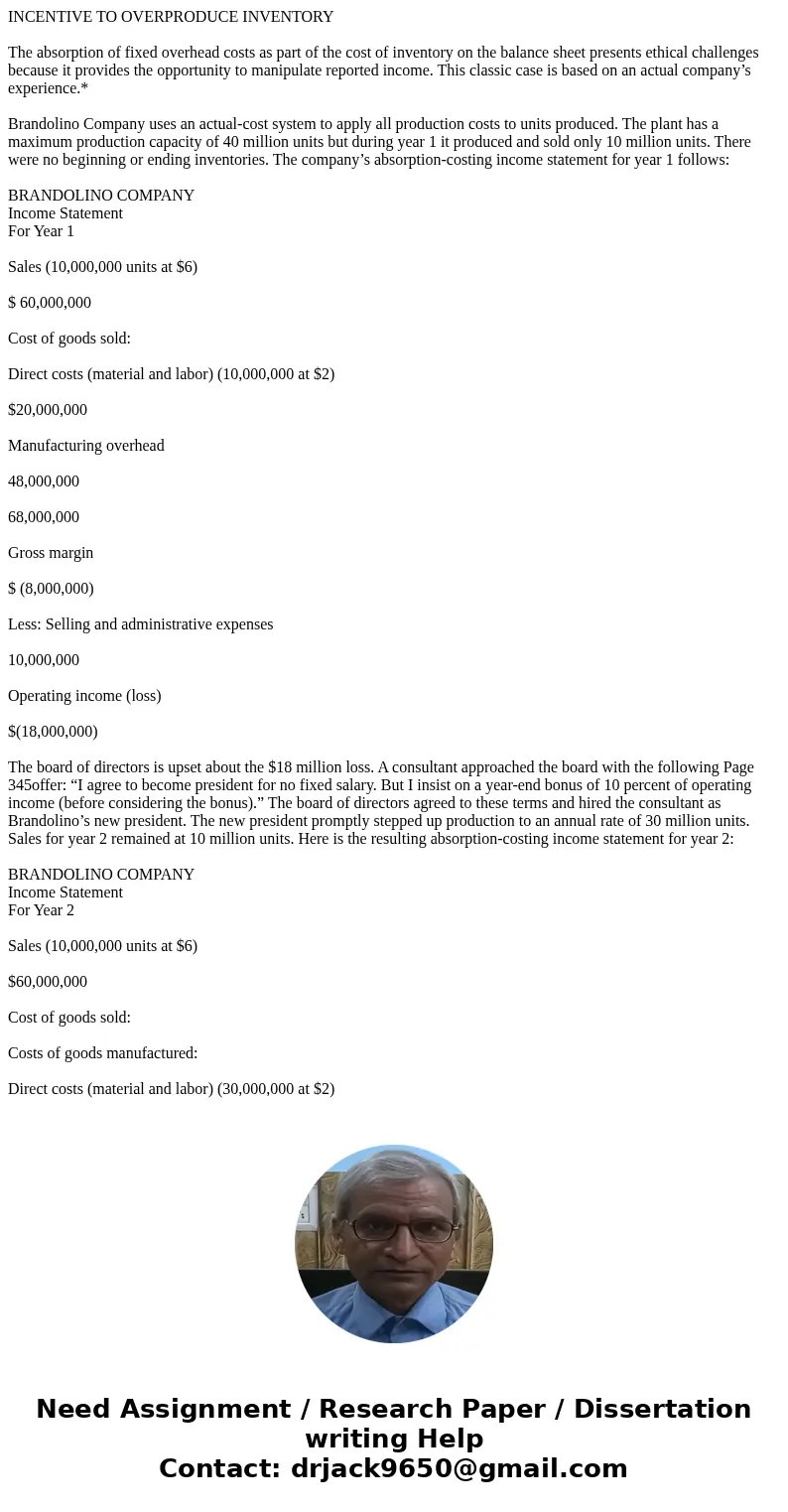
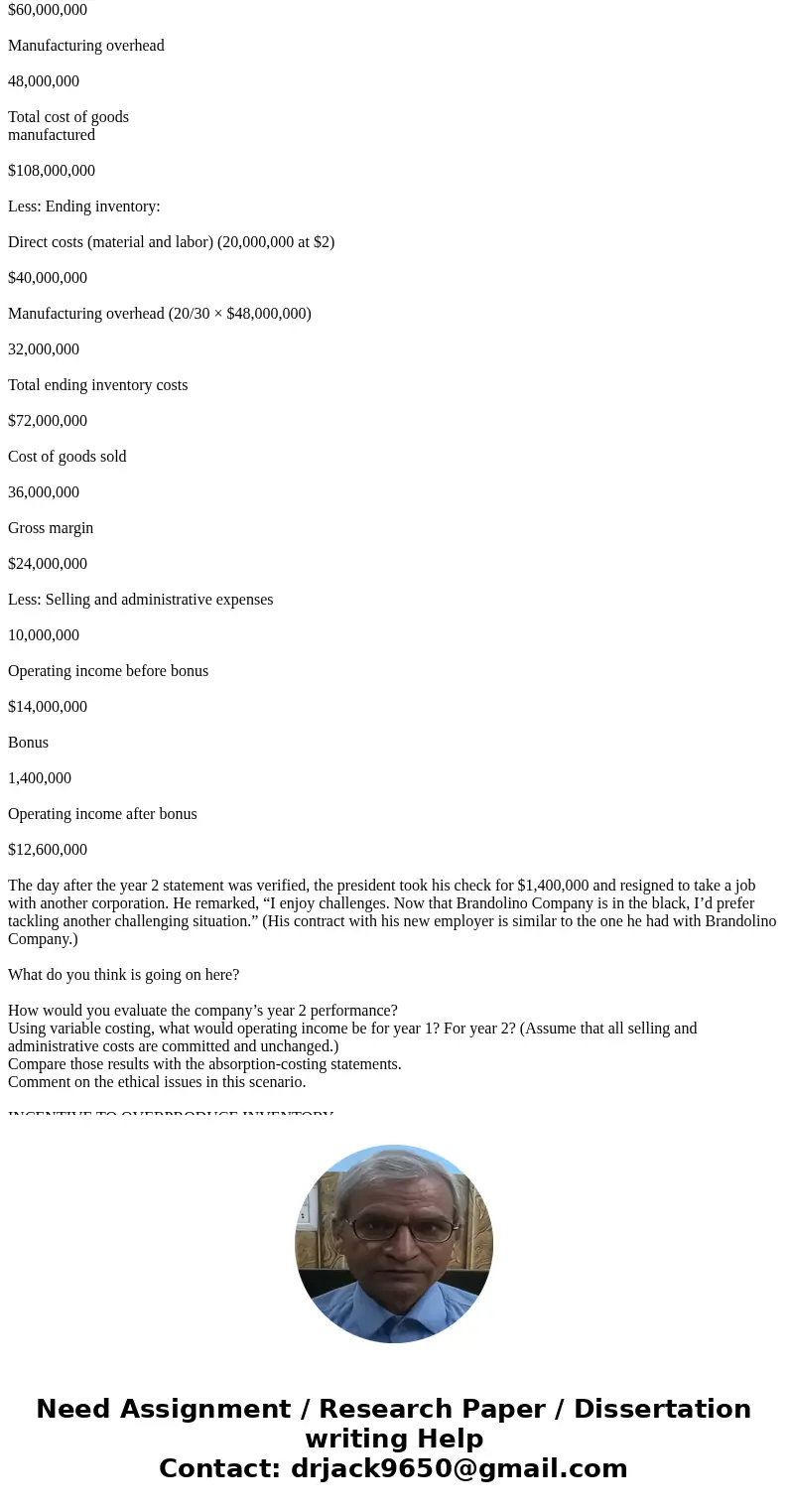
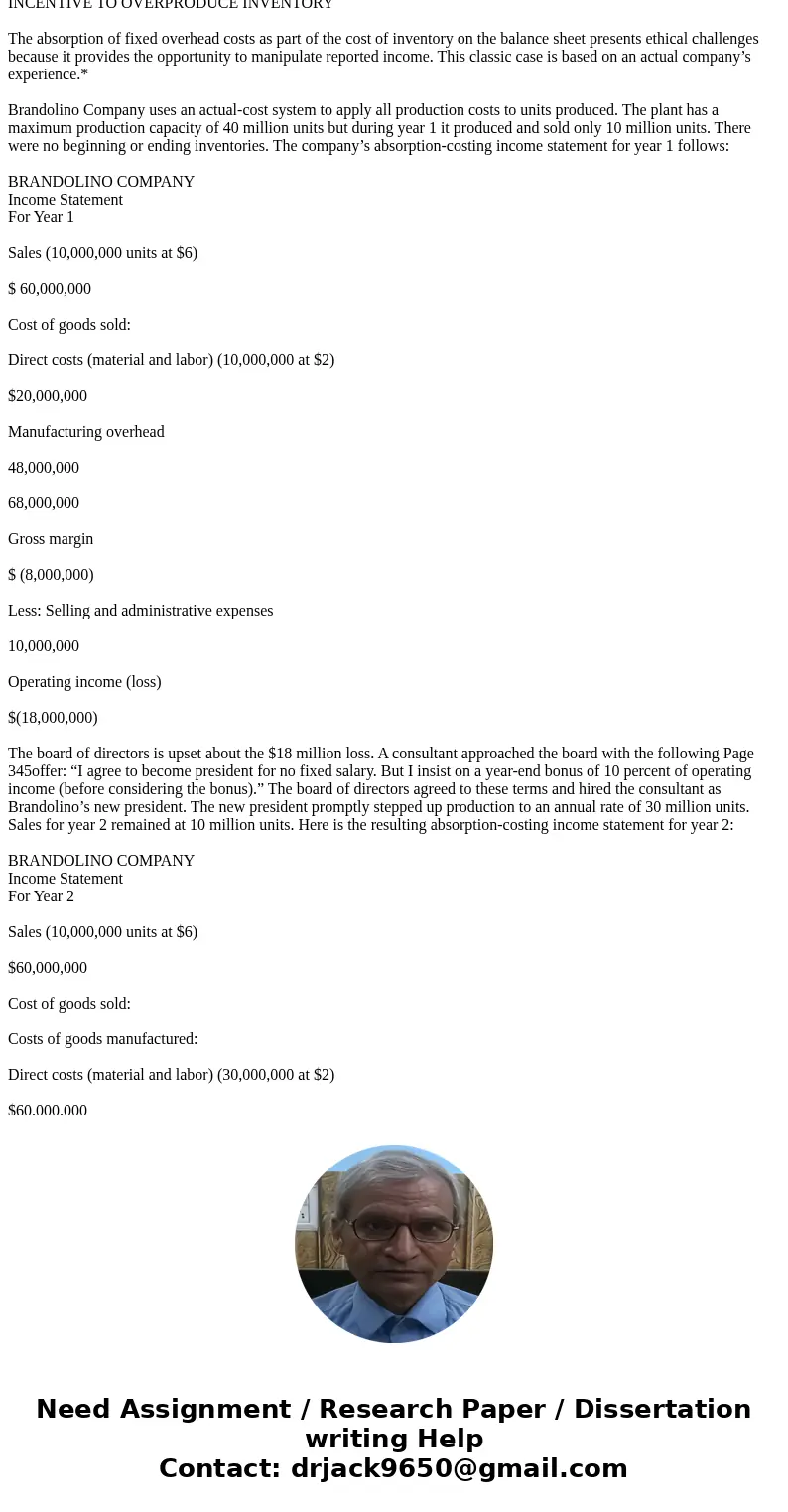
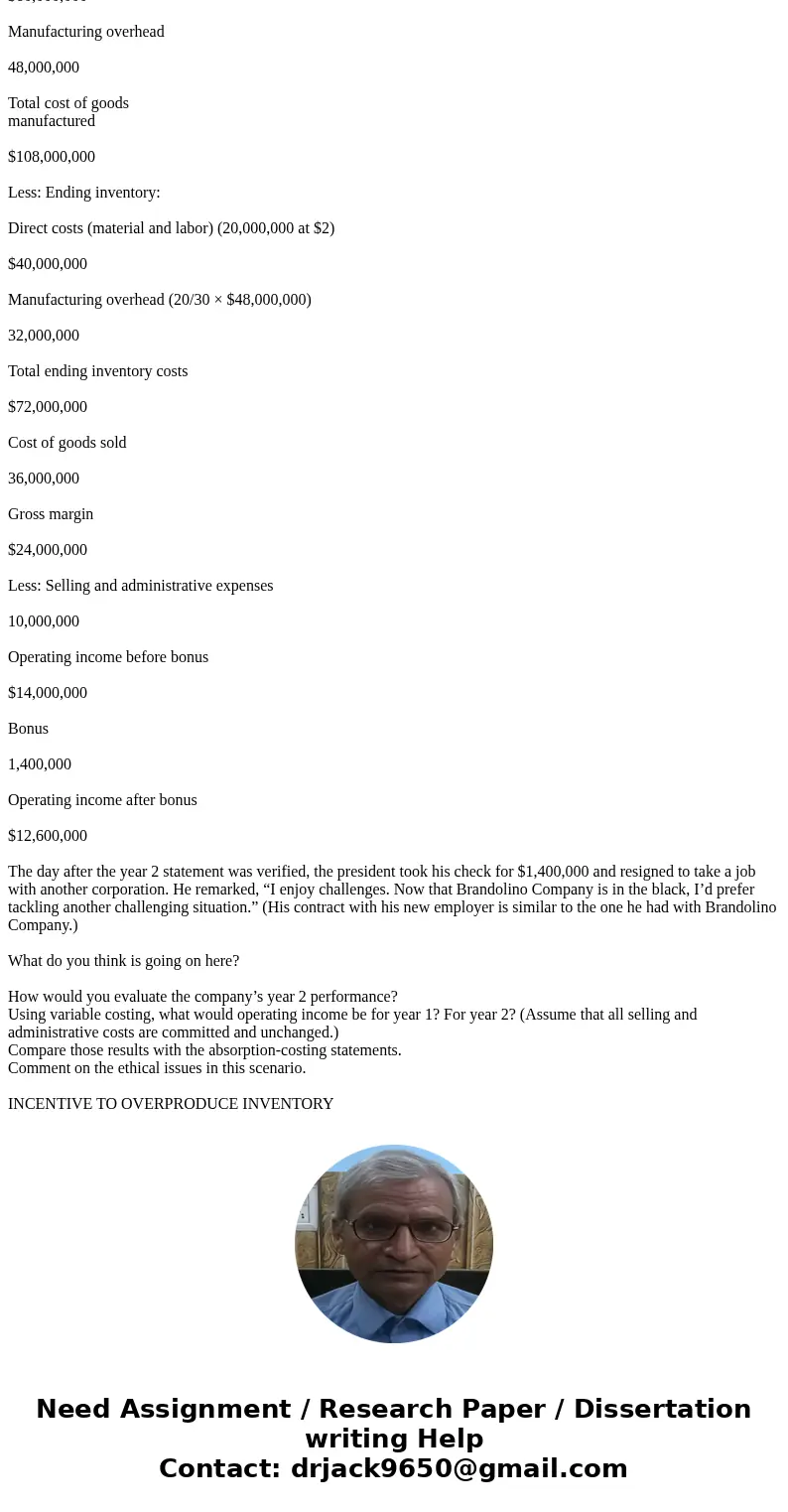
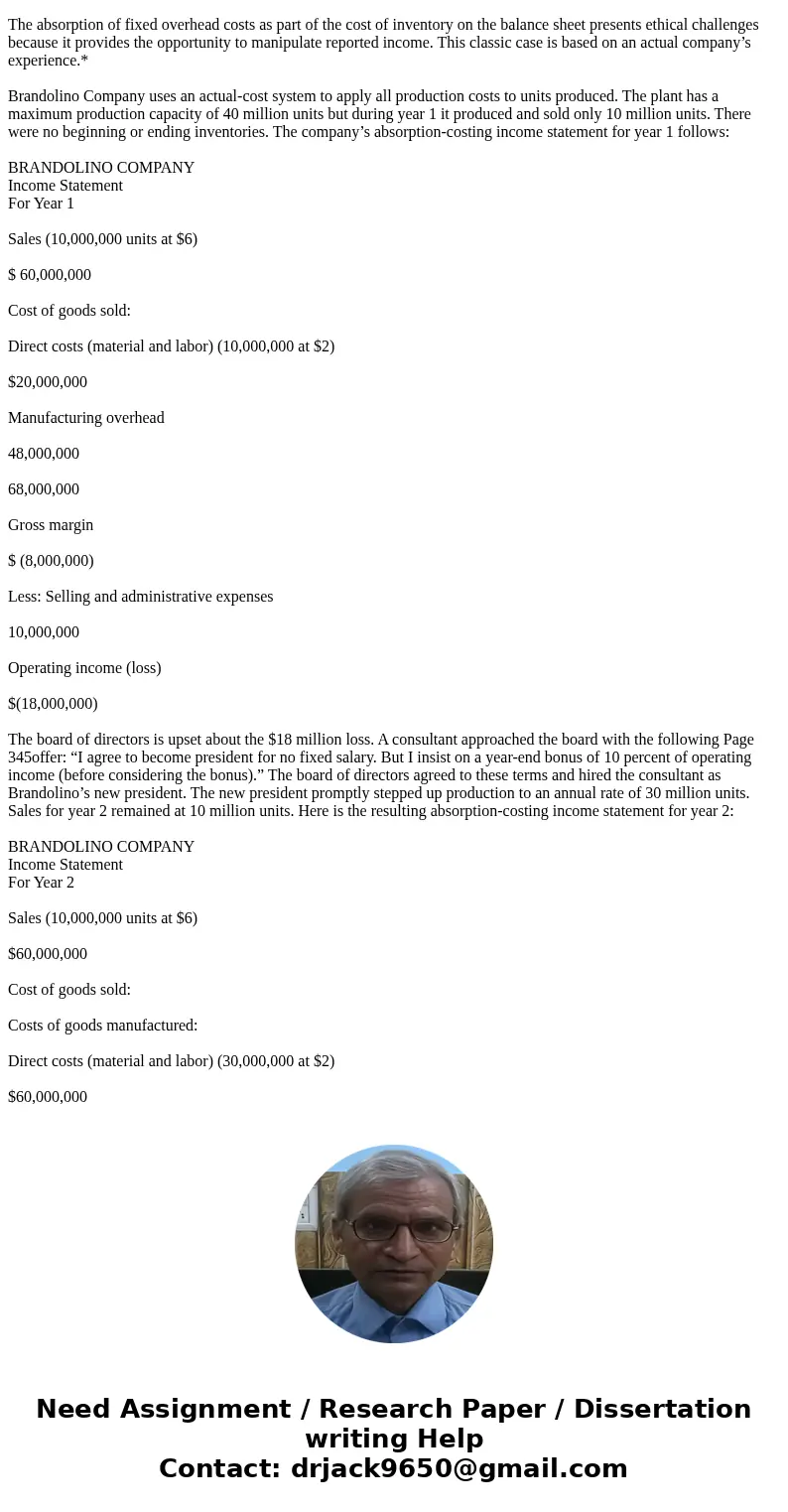
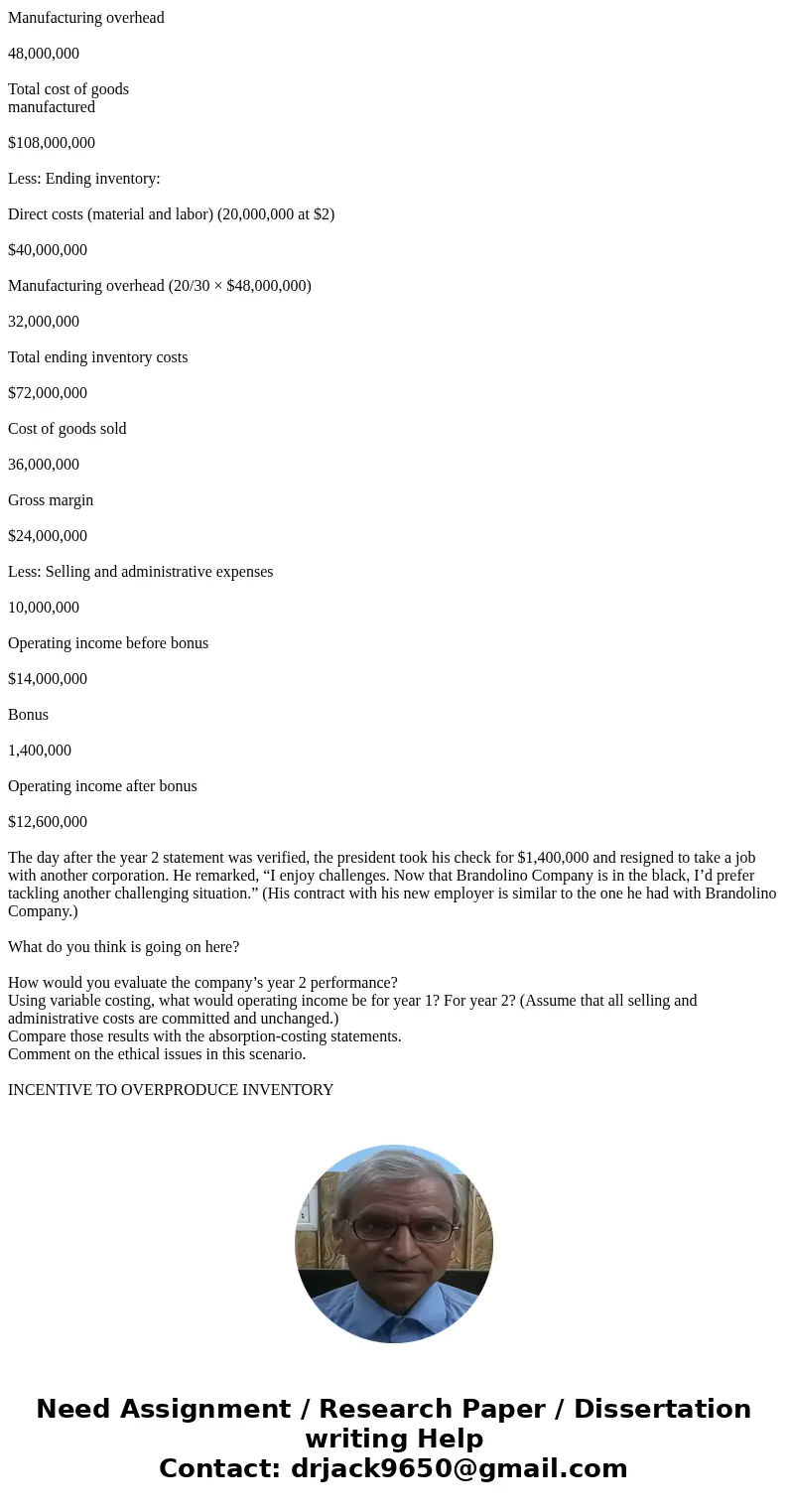
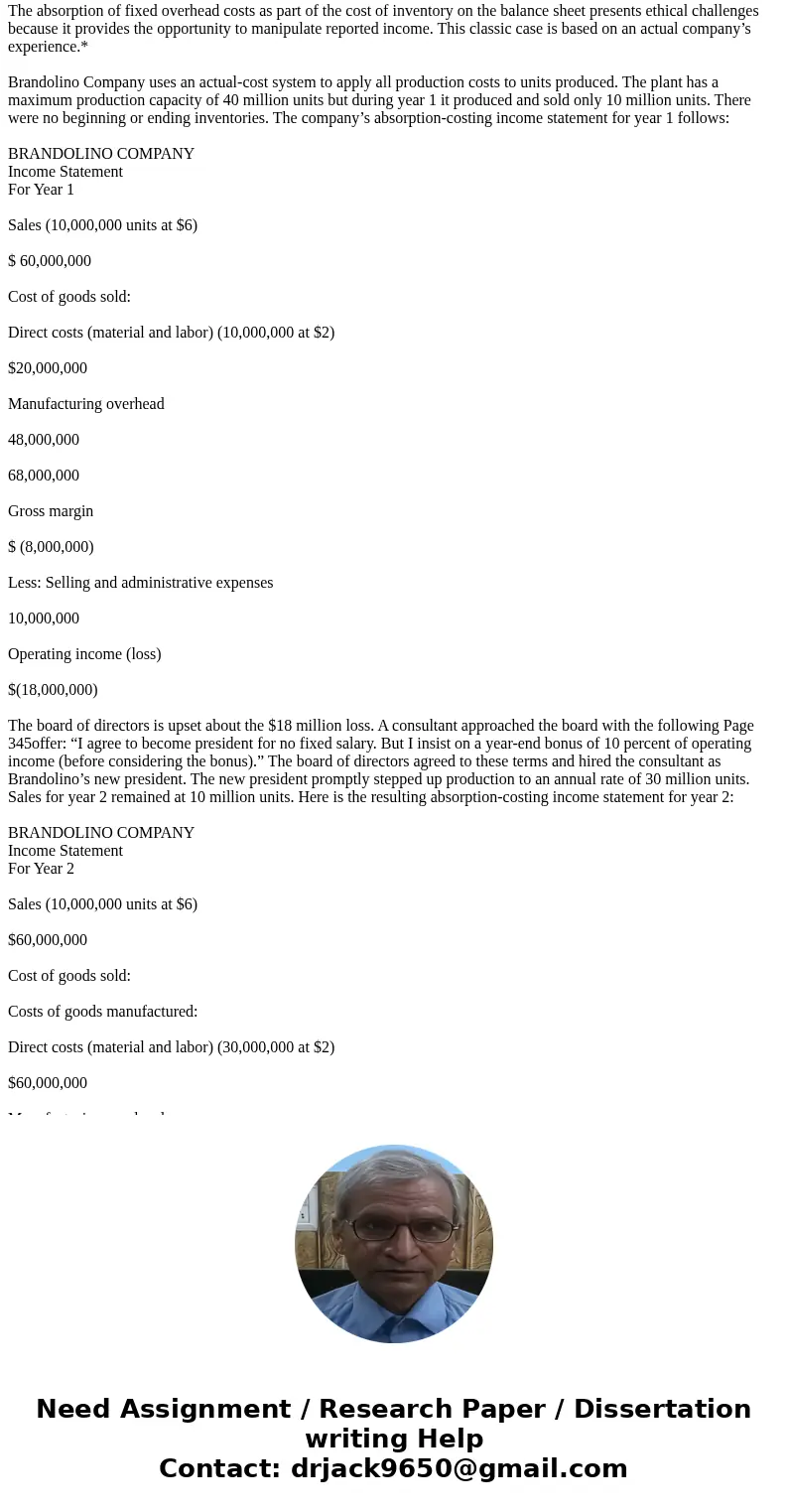
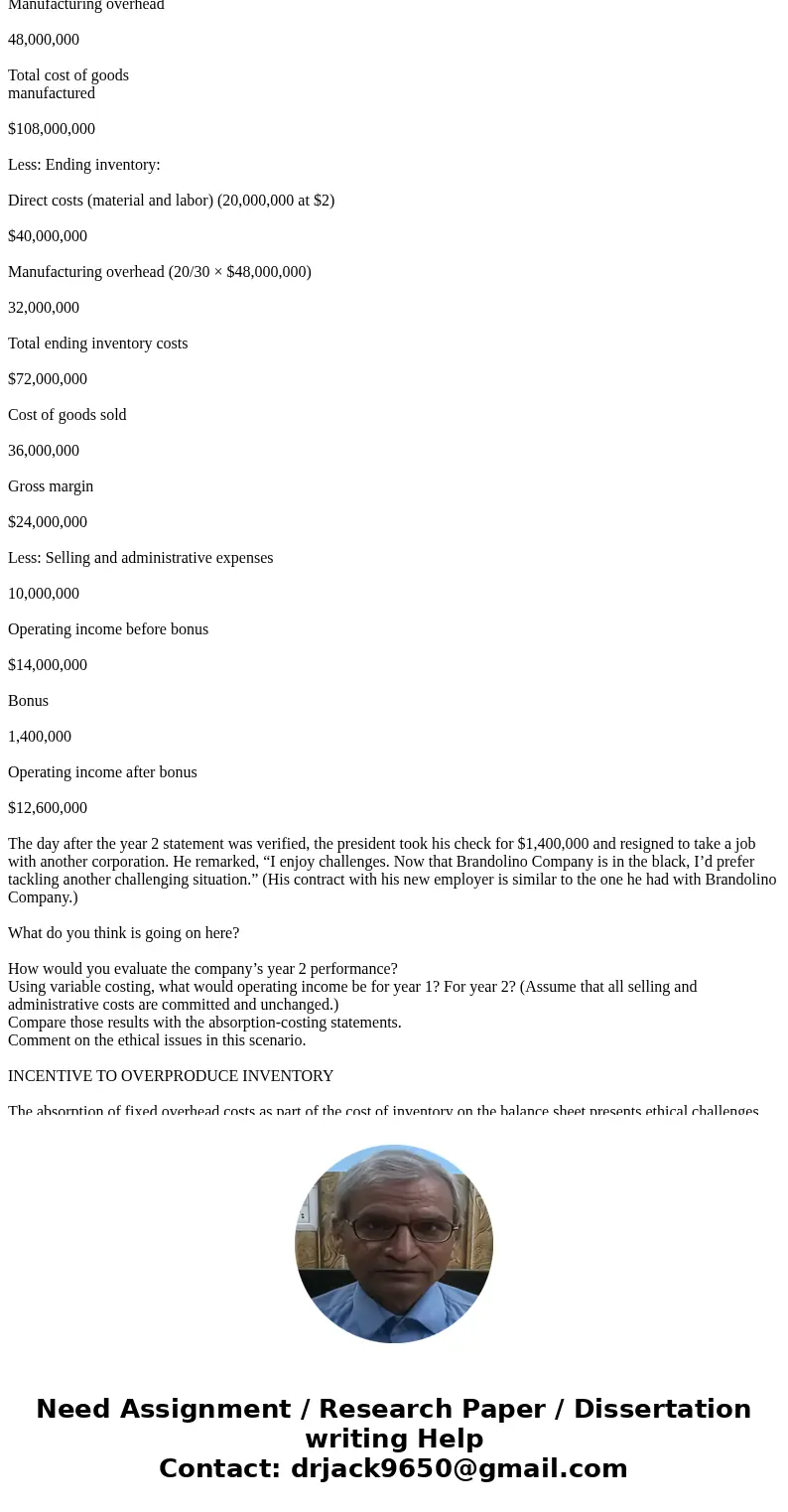
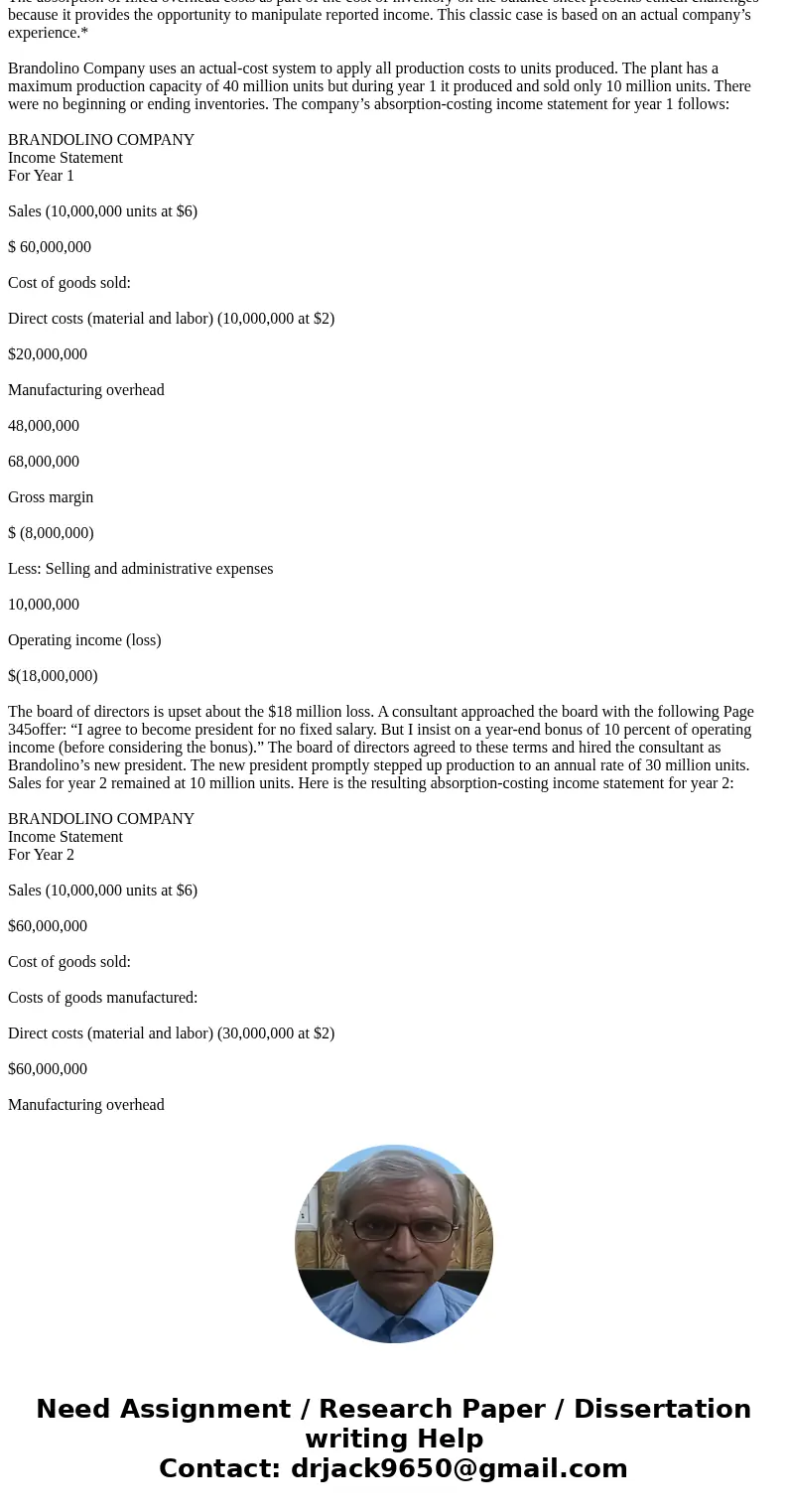
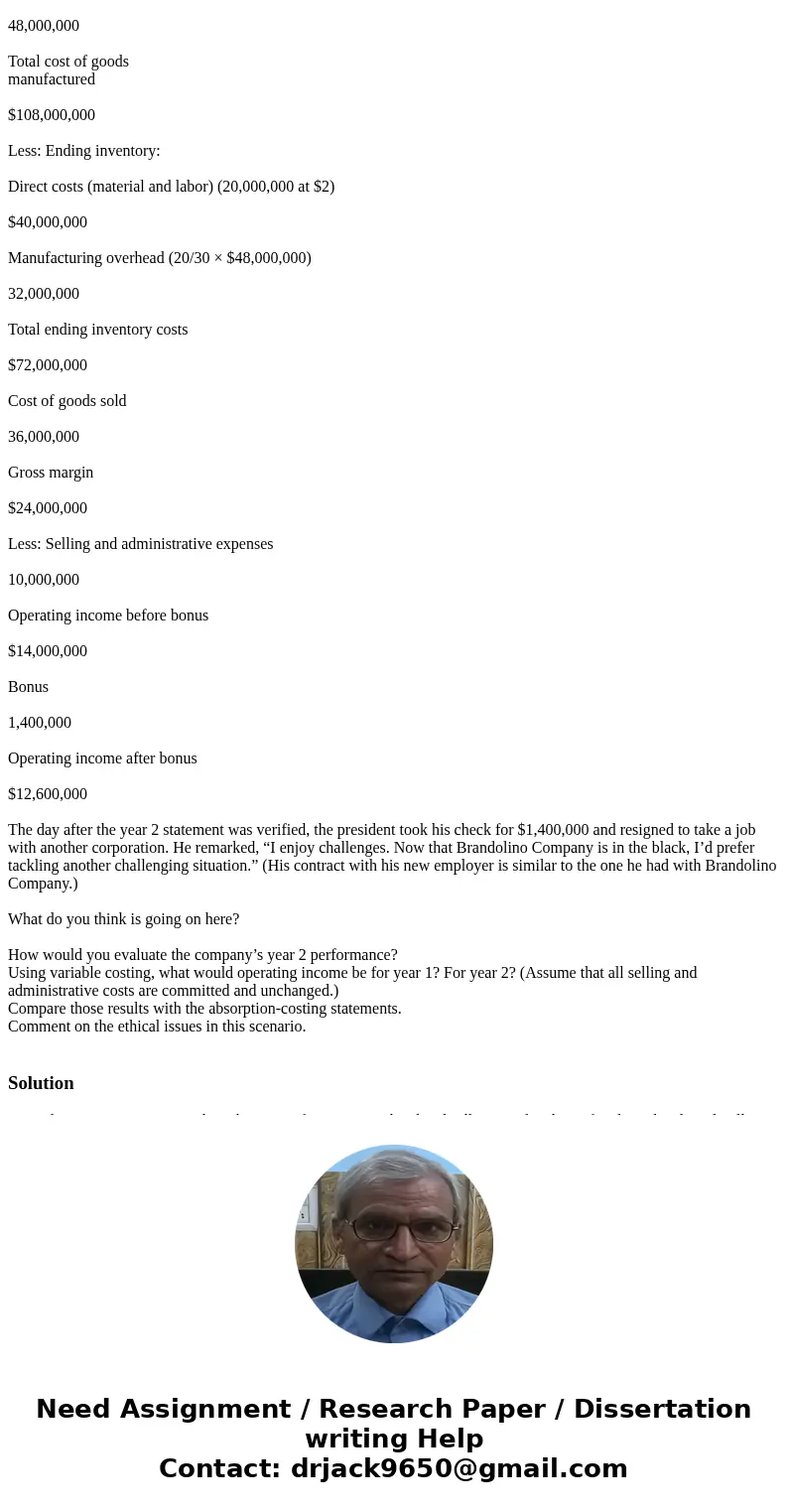
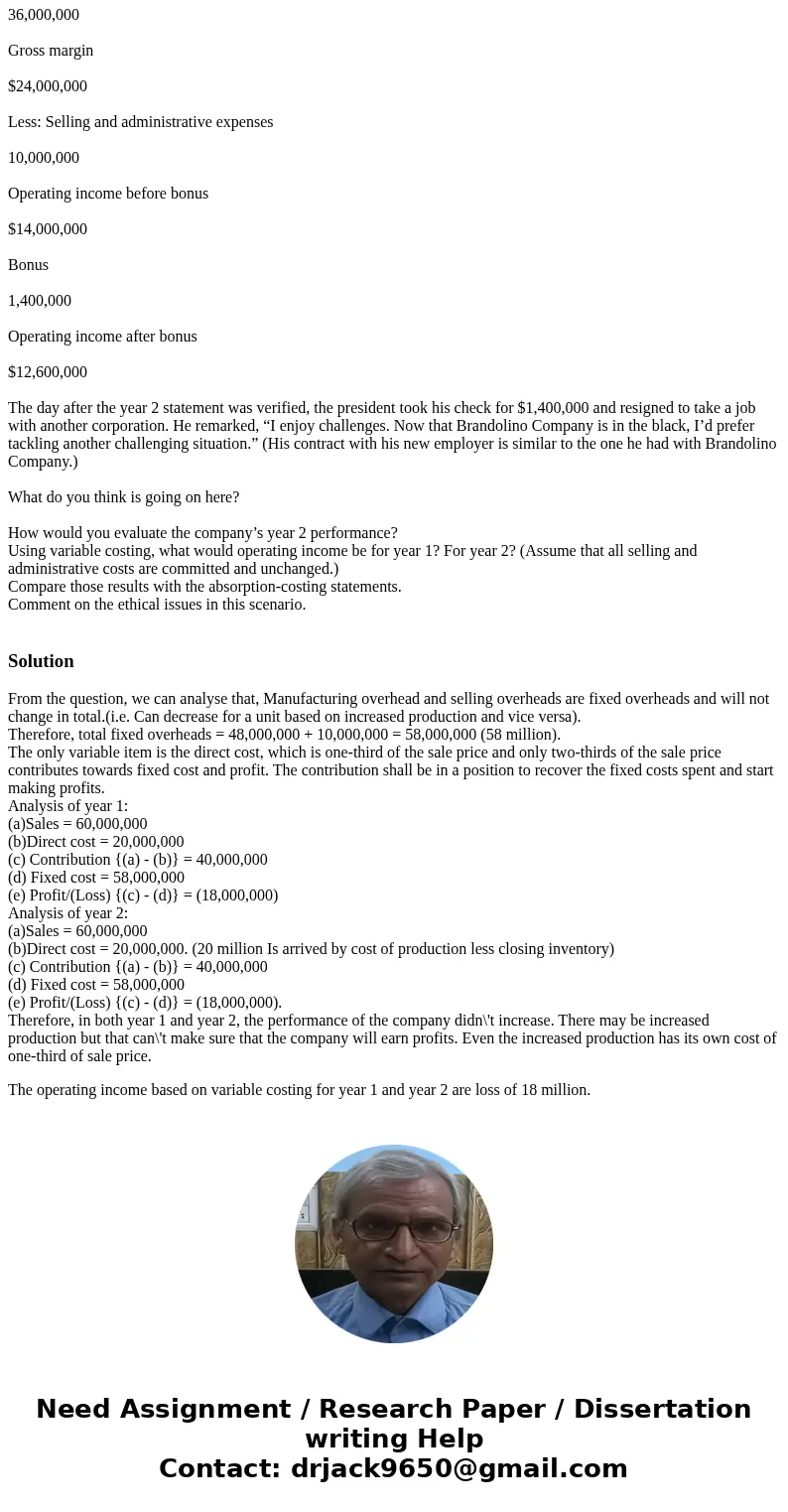
 Homework Sourse
Homework Sourse